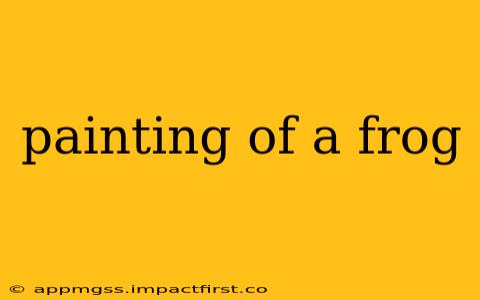Frogs, with their vibrant colors, unique textures, and expressive postures, make captivating subjects for painting. Whether you're a seasoned artist or just beginning your creative journey, capturing the essence of a frog on canvas can be a rewarding experience. This guide delves into the nuances of painting frogs, offering tips and techniques to help you create a truly stunning piece.
What kind of paint is best for painting a frog?
The best type of paint for painting a frog depends largely on your personal preference and the desired effect. Acrylics are a popular choice for their versatility, quick drying time, and ease of cleanup. Watercolors offer a delicate, translucent quality, ideal for capturing the subtle shades and textures of a frog's skin. Oil paints provide richness and depth of color, allowing for intricate detail and blending. Gouache, with its opaque nature, is also excellent for achieving vibrant, flat colors. Ultimately, the "best" paint is the one you feel most comfortable and confident using.
How do you paint a realistic frog?
Painting a realistic frog involves careful observation and attention to detail. Begin by studying your subject – a photograph, a live frog (if possible), or even a museum specimen. Note the variations in color and texture across its skin, the subtle highlights and shadows, and the unique shape of its body and limbs. Use a range of values and colors to create depth and dimension. Pay close attention to the reflective qualities of the frog's skin, especially in areas where light hits it directly. Consider using a light source to help highlight these areas. Accurate representation of anatomical details like bulging eyes, webbed feet, and smooth, moist skin is crucial for a realistic portrayal.
What are some good techniques for painting a frog?
Several techniques can be employed to effectively paint a frog:
- Layering: Build up the colors gradually, starting with lighter washes and adding darker layers to achieve depth. This is particularly useful with watercolors and acrylics.
- Blending: Smoothly transition between colors to create a seamless look, especially when depicting the frog's skin tones. This is more readily achieved with oil paints.
- Dry brushing: Use a dry brush with minimal paint to create a textured effect, mimicking the bumpy skin of some frog species.
- Impasto: Apply thick layers of paint to create texture and dimension, which can be especially effective in portraying the frog's skin's unique surface.
What colors should I use to paint a frog?
The color palette you choose will depend entirely on the species of frog you are painting. Some frogs are brilliantly colored, while others are more subdued. Observe your reference carefully and note the specific hues. Don't be afraid to mix your own colors to achieve the exact shades you need. Common colors used for painting frogs include greens, browns, yellows, oranges, and various shades of gray.
How do I paint a cartoon frog?
Painting a cartoon frog allows for greater creative freedom. Simplify the shapes and forms, using bold colors and lines to create a fun and expressive character. Exaggerate features like the eyes and mouth to add personality. Experiment with different styles, from cute and cuddly to quirky and mischievous. The possibilities are endless!
How do I paint a frog in watercolor?
Watercolor is ideal for capturing the delicate beauty of a frog. Start with a light wash to establish the overall tone. Build up the layers gradually, allowing each layer to dry before applying the next. Use clean water to lift and soften colors, creating subtle transitions and textures. Emphasize the transparency of the watercolor by layering washes to achieve depth and richness. Experiment with wet-on-wet and wet-on-dry techniques for different effects.
This guide provides a foundational understanding of painting frogs. Remember that practice is key; the more you paint, the more confident and skilled you will become. Don't be afraid to experiment, try different techniques, and develop your own unique style. The beauty of art lies in its individuality, so embrace your creativity and have fun!
